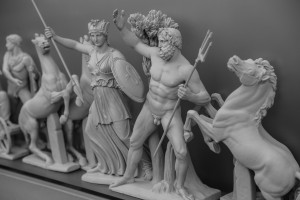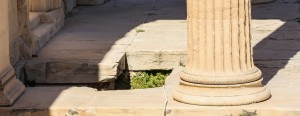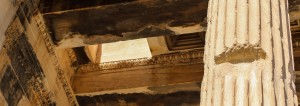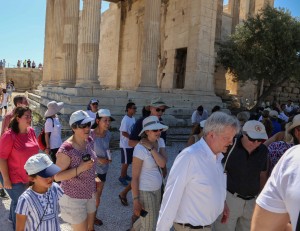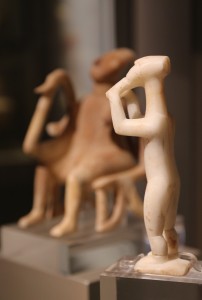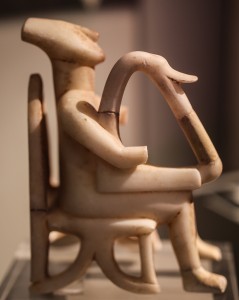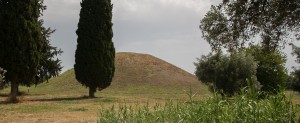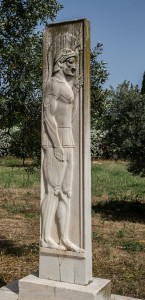A guest post by Safdar Mandviwala
It was a sweltering day in Athens, temperatures rising to 43 degrees Celsius, (109 degrees Fahrenheit) but we had a tight and busy schedule. The three-hour bus ride the day before from Delphi was sleepy and uneventful, allowing us to recharge. Professor Nagy led the charge on the morning of June 16 through the colorful streets of Plaka toward the Acropolis, a ten-minute walk from our hotel. For those of us who had not visited before, the first sight of the ancient citadel from below was breathtaking. While we waited for our tickets to be collected, Professor Nagy, as per norm, explained some of the highlights we should look for during our ascent and atop the plateau. Given the crowds this preview allowed for a very efficient tour of the Acropolis, with Professor Nagy in some places only having to point to a spot without shouting over the masses.
As we climbed the steps with Helios, we saw hidden Cyclopean Walls behind some of the (relatively) newer construction, ‘windows’ into the early Mycenaean era of this site.
Looking below, we observed the Theatre of Dionysus and the Ancient Agora, which we would explore later that day. At the citadel we tarried at the magnificent Parthenon for the obligatory selfie before being ushered towards the Erechtheion where we observed the gaping hole in the ceiling said to have been torn open by wrathful Poseidon’s trident and the corresponding (now dry) sea-water fissure where it struck the floor.
Around the corner was the olive tree offered by Athena in competition with Poseidon to become patron deity of the city.
Back beneath the Acropolis, we trekked a short distance to the New Acropolis Museum. With its second floor specifically positioned to align with the Parthenon, the highlight of this museum was the placement of Parthenon Frieze marbles all around the second floor as they would have been in their original juxtapositions. (The marble figurine on the ground floor resembling Kate Winslet was a close second!) Gaps and replicas filled in for marbles that had either been destroyed or carted off to foreign lands (e.g. the Elgin Marbles removed by the 7th Earl of Elgin from 1801–1812 and now displayed in the British Museum.)
From the New Acropolis Museum to the Ancient Agora: quite a hike in the fierce heat, but well worth it. Here we paid our respects at the Altar of the Twelve Gods, observed the Monument of Eponymous Heroes, and made a special visit to the area where Socrates was imprisoned and breathed his last after drinking the prescribed cup of poison hemlock. A short tour of the in situ museum before heading back to the hotel.
The morning of June 17 saw us take a short bus ride to the National Archaeological Museum. There was so much to see in this treasure-house. We first marveled at the small Parian marble statuettes of the harper and flutist of Keros from the early Cycladic Period (2800–2300 BCE.)
Other highlights on the ground floor include ancient Mycenaean period golden signet rings, masks, scales and embossed butterflies. There we saw the Monumental Attic grave-amphora from the Late Geometric period (760–750 BCE) depicting a funeral scene.
Also incredibly preserved, beautiful statue of a korē, in Parian marble which stood atop the grave of Phrasikleia (550-540 BC).
The second floor is a museum unto itself and we were fortunate that it was open on the day of our visit. Filled with an assortment of black- and red-figure pottery, it was a delight to see some the depictions we studied during HeroesX in their actual forms.
There were no crowds at Marathon on the morning of June 18, but the sights there were of no lesser significance. Marathon is of course famous for the marathon run which derives from the legend of Philippedes. The name Marathon comes from the legend of Philippides or Pheidippides, the Greek messenger. The legend states that he was sent from the battlefield of Marathon to Athens to announce that the Persians had been defeated in the Battle of Marathon (in which he had just fought), which took place in August or September, 490 BCE. It is said that he ran the entire distance without stopping and burst into the assembly, exclaiming νενικήκαμεν (nenikēkamen, “we have won!”), before collapsing and dying. The account of the run from Marathon to Athens first appears in Plutarch’s On the Glory of Athens in the 1st century CE, which quotes from Heraclides Ponticus’s lost work, giving the runner’s name as either Thersipus of Erchius or Eucles. Lucian of Samosata (2nd century CE) also gives the story, but correctly names the runner Philippides (not Pheidippides.)
Source: Wikipedia
The Battle of Marathon in 490 BCE is monumental in Greek history as it was the first time the Greek army (in this case, almost exclusively comprising Athenian forces) were able to defeat the Persians under King Darius I, against unfavorable odds. Out of the plain of Marathon today rises the tumulus supposedly containing the bodies of the 192 Athenians who died in the battle.
There is a statue for Miltades, the Athenian general who commanded the Greek forces.
Pausanius in his account says:
{1.32.4} There is also an individual monument [mnēma] for one man, Miltiades son of Kimon, although his end [teleutē] happened later, after he had failed to capture Paros and for this reason had been put on trial by the Athenians. At this place [= Marathon] every night you can hear horses neighing and you can sense that men are fighting in combat. No one who has deliberately set out to experience this vision [théā] in-full-view [en-argēs] has ever really had any success, but still, if something is experienced in some alternative way by someone who has no ear for such things, this is no cause for anger [orgē] on the part of the spirits [daimones].
So, good for us we visited in the morning! There is a museum at Marathon in which we sighted a dedication inscription to Herakles from the 5th century BCE, found at Valaria, Marathon.
It was at the farewell dinner that night that we all realized how attached we had become to one another. Over yet another delicious meal the study-group discussed the highlights of the trip; savoring the flavors and the fresh memories of Greece. Next morning we would each go our separate ways, but with a common understanding of ancient Greek history, culture, language, and mythology through the unique lens of this travel-study.
You can join the conversation on the Forum thread.
___
Safdar Mandviwala lives in Dubai, originally from Pakistan, and is (or was) a career banker of 22 years. He is now in search of a new identity and first joined HeroesX v.4, after which he traveled with Professor Nagy who led the travel-study program to Greece in June 2016. With his new-found passion for ancient Greek literature, he plans to learn and participate on the Hour 25 Forums as much as possible.
Image credit: Safdar Mandviwala
